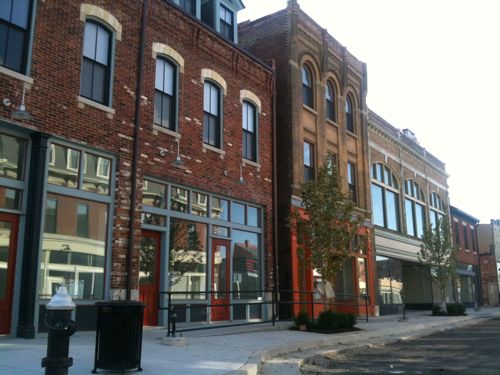Poll On Missouri’s Historic Tax Credit Program

The State of Missouri is facing a budget crunch so everything is on the table, including tax credits:
“Missouri has 61 tax credit programs that waived $521 million in state income taxes last year. Costs for tax credits have increased five-fold during the past dozen years while state revenues have risen much less.” (AP via Bloomberg)
One credit that may be scaled back is the historic tax credit:
“Gov. Jay Nixon’s tax credit commission recommended Tuesday lowering Missouri’s annual cap on historic tax credits from $140 million to $75 million a year.
The commission said the reduction, which would be permanent, should cover all historic renovation activity under the program. Nearly $100 million in historic tax credits were authorized in 2010, according to the commission’s report.”  (St. Louis Business Journal)

In 2010 “nearly $100 million in historic tax credits were authorized” so lowering the cap would reduced the number of projects getting renovated using the tax credit. Â This is the subject of the poll this week. Â I want to know how you, the readers, feel about the cap being lowered. Â The poll is in the upper right corner of the blog.
– Steve Patterson
You stated it, “The State of Missouri is facing a budget crunch so everything is on the table”. This is special interest legislation that benefits a limited group of people and is applied inequitably across the state. As inner ring suburbs that grew rapidly after WW II struggle to reinvent themselves, they're in competition with older, “more-historic” cities like St. Louis for scarce state resources. There's no question that the tax credit has helped places like Washington Avenue and the Delmar Loop; the question now is whether or not that level of support can or should be sustained? At the expense of things like pensions, higher education or public infrastructure? And, at its core, historic tax credits aren't that much different than TIF's, with government becoming a partner in the development game, helping a select few, at the expense of the many . . .
The point is that this program benefits an extremely limited group of buildings across the state. It is untrue that the HTC only benefits places like Washington Avenue or the City of St. Louis. Buildings and main streets in Carthage, Hannibal, Sedalia and small towns all over the state have benefited economically from this program, to say nothing of construction activity and permanent jobs that result from restoration and reuse of irreplaceable historic architecture. It is tiresome to read ignorant, antagonistic, and factually baseless outstate Repub fantasies of the HTC in which “fat cats” in Sodom and Gomorrah (that's St. Louis and Kansas City, for those of you who will not be swept up in the rapture) who are juiced in with godless tax and spend liberals are able to obtain wheelbarrow loads of cash for their “pet projects”, while the “real Missourians” are just down home honest folks who want services for everyone but don't want to pay any taxes whatsoever if they can help it.
It is bullshit, plain and simple, and unfortunately, like bullshit in a lot of other places, it plays. Clear, independent, economic evaluations of the impact of HTC are available, if people want to find out exactly how the credits actually work and how they benefit the state. Too many people, unfortunately, are dedicated instead to nursing their deeply ingrained aversion to facts.
Agree with JZ71 and would say your just as bull headed as those many people who are supposedly have an aversion to facts. The reality of politics and state budget is that the state can't afford to continuously hand out tax credits at the amounts they are were handing out in past years. In fact, declining MO tax revenues does little to support whatever economic benefits are claimed nor does the demographics/census support a big influx of people to support the ideal world of supporting every rehab development dreamt of with a tax credit. Finally, you can take your arguement one step farther and say that if it is such a great idea that pays back immensely then the city or cities who benefit could support the program on their own. I'm sure their is going to be few politicians using that agruement against supporters.
In many ways, I think the fight is to keep the historic tax credits at $100 million (FY10's disbursement) for the next two years and how to get McKee's development unstuck. Those would be two big wins in the scheme of things. Otherwise, the all or nothing argument/fight this is bull@#$& might get you exactly that, nothing.
Tax credits, by definition, are taxes that you don't have to pay. It doesn't matter what they're for (historic rehab, energy conservation, saving the family farm, whatever), it means less revenue coming into the state. When times are good and revenues are up, it's possible to be more generous with all sorts of tax incentives. When times are tough and revenues are down, like they are now, then cuts need to be made in both spending and in “incentives” that negatively affect revenues. I don't disagree that HTC's can be justified, they just need to withstand the scrutiny they're going to receive in comparison to the many other “worthy” projects and programs out there. They may be your sacred cow, but for others, it's going to be parks, education, highways, whatever. You stated it correctly in your first sentence, “The point is that this program benefits an extremely limited group of buildings across the state.” If it benefitted a larger group of structures and/or communities, there'd be a larger constituency to justify maintaining the credits at current levels.
“If it benefitted a larger group of structures and/or communities, there'd be a larger constituency to justify maintaining the credits at current levels.”
Not to be rude, but what's your point? Are you pointing out something clearly obvious or suggesting that we hand out more $150 stimulus checks?
The one important thing to remember about targeted tax credits “that benefit the few” is that they get a bigger bang for the buck. For example, many complain of exorbinant C-level executive salaries. At my retailer, the CEO reported $4.3 million in 2009 in salary and stock options (that I read). Now if we said, “Wait, why benefit ONE MAN with so much of the company's resources. Let's benefit ALL EMPLOYEES!” and took $4 million dollars away from the CEO, gave him $300K a year, and spread the savings around the company, each employee would get another $17 in their paycheck FOR THE ENTIRE YEAR: $4 million divided by 244,000 employees. Seventeen bucks!!! And we'd end up with a CEO who wouldn't have the mental capacity and skills to run the company. No one qualified would run the company for that money.
Targeted investment that is large enough to a make significant impact on a community has a much better chance of sprouting into much larger revenue producers down the line. Those stimulus checks from a few years ago surely helped the economy, but that money is now spent and gone. Something like the HTC has a legacy that will generate income for many years to come. (I bet all of these downtown St. Louis lofts will contain property tax payers for many, many years to come.)
Remember, too, that tax credits are, as you say, taxes that you don't have to pay. But the percentage that is paid will be more than what the government would collect if a project never happened. Sure taxes are not collected during a tax abatement period on a loft project. But once that expires, the city and state will begin collecting.
I am one who believes that the St. Louis region would suffer more from well over 100 vacant and decaying buildings in its Central Business District and acres of decaying neighborhoods within the City, than from whatever short term tax collection hits are taken to encourage development that has the potential to pay a lot of bills for many years down the line.
I think there are less than 10 vacant buildings left downtown? What would that number be w/o the HTC? Should the HTCs not have been given? Is the urban implosion of Detriot something we want here? We cannot dictate and plan our communities through a centralized, authortarian gov't, but we can influence community development through tax policy.
Anyone who suggests that the HTC benefits only a few really doesn't understand the economic impacts of this tax policy and should speak with the raw material, construction, planning, hospitality, and neighborhood services teams/organizations that clearly benefit from developments encouraged by the HTC. Not to mention the benefit of a positive impression that future investors will have of St. Louis. Someone may be from Chesterfield or Alton or Barnhart, but brother they are all St. Louis to anyone not from here. If I'm from Washington, MO, I don't want Wash Ave of 15 years ago representing me. Or the current north St. Louis either.
Exactly so.
I’ve been on many jobs that were made possible by these tax credits. It doesn’t make sense to provide these incentives when the economy is good and to get rid of them when they are needed.Â
It is this type of spending that encourages economic activity. One good question is how much of that tax credit is earned back by taxes generated by the project itself in the way of sales tax on goods and state income tax paid by the contractors and employees employed by the project.
stlwoodfloors.com
I’ve been on many jobs that were made possible by these tax credits. It doesn’t make sense to provide these incentives when the economy is good and to get rid of them when they are needed.
It is this type of spending that encourages economic activity. One good question is how much of that tax credit is earned back by taxes generated by the project itself in the way of sales tax on goods and state income tax paid by the contractors and employees employed by the project.
stlwoodfloors.com